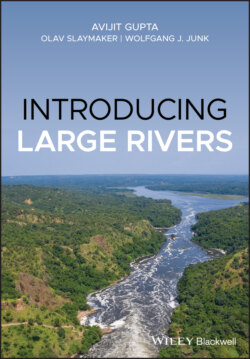Читать книгу Introducing Large Rivers - Avijit Gupta - Страница 2
Table of Contents
Оглавление1 Cover
2 Preface Note
3 1 Introduction 1.1 Large Rivers 1.2 A Book on Large Rivers References
4 2 Geological Framework of Large Rivers 2.1 Introduction 2.2 The Geological Framework: Elevated Land and a Large Catchment 2.3 Smaller Tectonic Movements 2.4 The Subsurface Alluvial Fill of Large Rivers 2.5 Geological History of Large Rivers 2.6 Conclusion References
5 3 Water and Sediment in Large Rivers 3.1 Introduction 3.2 Discharge of large Rivers 3.3 Global Pattern of Precipitation 3.4 Large River Discharge: Annual Pattern and Long-Term Variability 3.5 Sediment in Large Rivers 3.6 Conclusion References
6 4 Morphology of Large Rivers 4.1 Introduction 4.2 Large Rivers from Source to Sink 4.3 The Amazon River 4.4 The Ganga River 4.5 Morphology of Large Rivers: Commonality and Variations 4.6 Conclusion References
7 5 Large Rivers and their Floodplains: Structures, Functions, Evolutionary Traits and Management with Special Reference to the Brazilian Rivers 5.1 Introduction 5.2 Origin and Age of Rivers and Floodplains 5.3 Scientific Concepts and their Implications for Rivers and Floodplains 5.4 Water Chemistry and Hydrology of Major Brazilian Rivers and their Floodplains 5.5 Ecological Characterisation of Floodplains and their Macrohabitats 5.6 Ecological Responses of Organisms to Flood-Pulsing Conditions 5.7 Biodiversity 5.8 The Role of Rivers and their Floodplains for Speciation and Species Distribution of Trees 5.9 Biogeochemical Cycles in Floodplains 5.10 Management of Amazonian River Floodplains 5.11 Policies in Brazilian Wetlands 5.12 Discussion and Conclusion Acknowledgements References Notes
8 6 Large River Deltas 6.1 Introduction 6.2 Large River Deltas: The Distribution 6.3 Formation of Deltas 6.4 Delta Morphology and Sediment 6.5 The Ganga-Brahmaputra Delta: An Example of a Major Deltaic Accumulation 6.6 Conclusion References
9 7 Geological History of Large River Systems 7.1 The Age of Large Rivers 7.2 Rivers in the Quaternary 7.3 Changes During the Holocene 7.4 Evolution and Development of the Mississippi River 7.5 The Ganga-Brahmaputra System 7.6 Evolution of the Current Amazon 7.7 Evolutionary Adjustment of Large Rivers References
10 8 Anthropogenic Alterations of Large Rivers and Drainage Basins 8.1 Introduction 8.2 Early History of Anthropogenic Alterations 8.3 The Mississippi River: Modifications before Big Dams 8.4 The Arrival of Large Dams 8.5 Evaluating the Impact of Anthropogenic Changes 8.6 Effect of Impoundments on Alluvial Rivers 8.7 Effect of Impoundments on Rivers in Rock 8.8 Large-scale Transfer of River Water 8.9 Conclusion References
11 9 Management of Large Rivers 9.1 Introduction 9.2 Biophysical Management 9.3 Social and Political Management 9.4 The Importance of the Channel, Floodplain, and Drainage Basin 9.5 Integrated Water Resources Management 9.6 Techniques for Managing Large River Basins 9.7 Administering the Nile 9.8 Conclusion References
12 10 The Mekong: A Case Study on Morphology and Management 10.1 Introduction 10.2 Physical Characteristics of the Mekong Basin 10.3 The Mekong: Source to Sea 10.4 Erosion, Sediment Storage and Sediment Transfer in the Mekong 10.5 Management of the Mekong and its Basin 10.6 Conclusion References
13 11 Large Arctic Rivers Introduction 11.2 Physiography and Quaternary Legacy 11.3 Hydroclimate and Biomes 11.4 Permafrost 11.5 Anthropogenic Effects 11.6 Discharge of Large Arctic Rivers 11.7 Sediment Fluxes 11.8 Nutrients and Contaminants 11.9 Mackenzie, Yukon and Lena Deltas 11.10 Significance of Large Arctic Rivers Acknowledgment References
14 12 Climate Change and Large Rivers 12.1 Introduction 12.2 Global Warming: Basic Concept 12.3 A Summary of Future Changes in Climate 12.4 Impact of Climate Change on Large Rivers 12.5 Climate Change and a Typical Large River of the Future 12.6 Conclusion References
15 Index
16 End User License Agreement
